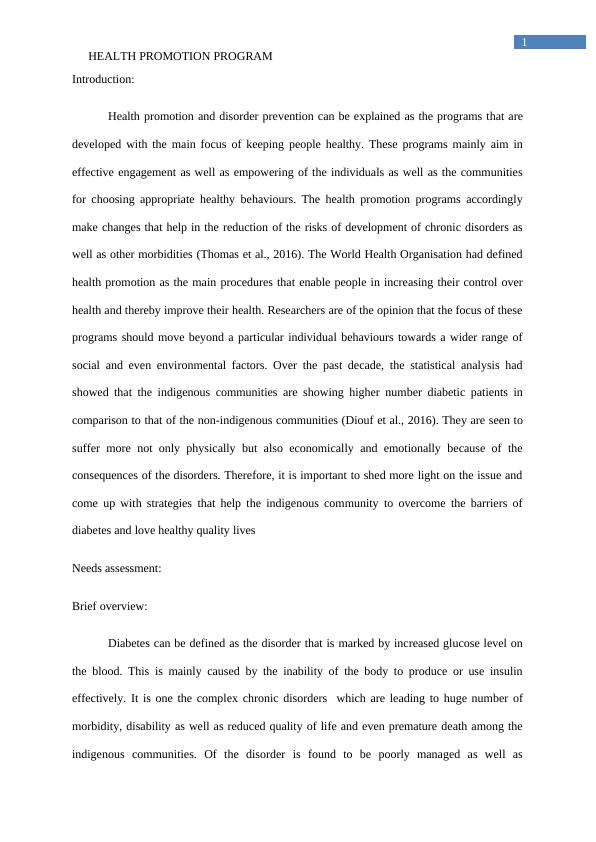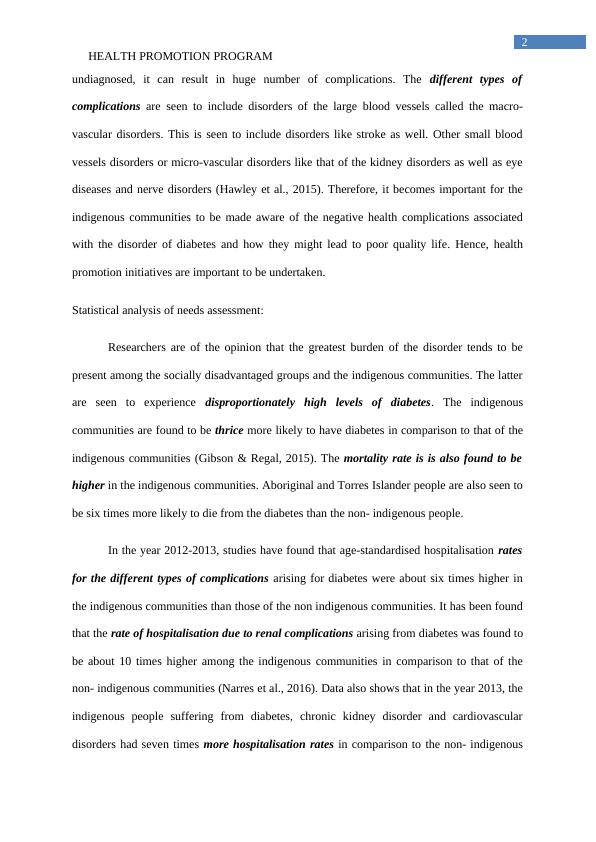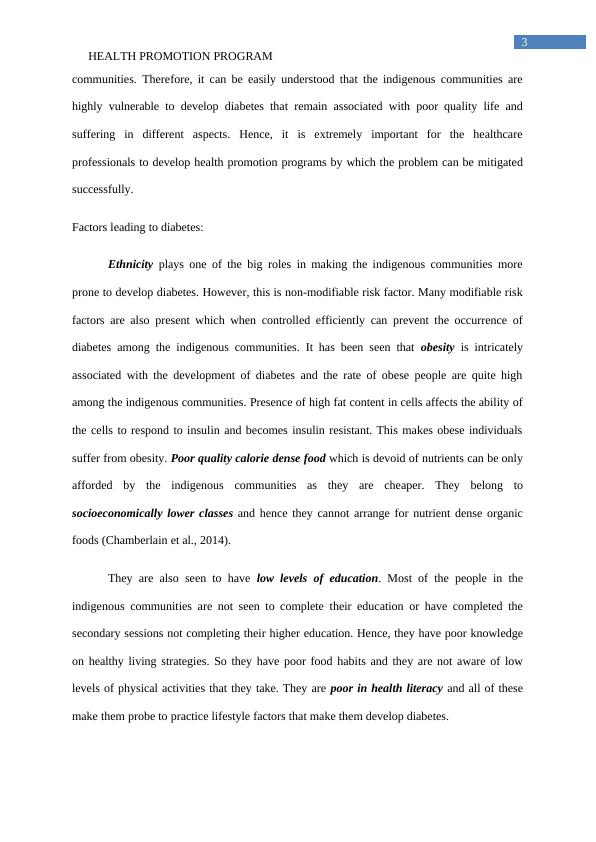Health promotion Program PDF
17 Pages4124 Words69 Views
Added on 2021-09-14
Health promotion Program PDF
Added on 2021-09-14
ShareRelated Documents
Running head: HEALTH PROMOTION PROGRAM
HEALTH PROMOTION PROGRAM
Name of the program:
Name of the university:
Author note:
HEALTH PROMOTION PROGRAM
Name of the program:
Name of the university:
Author note:

1
HEALTH PROMOTION PROGRAM
Introduction:
Health promotion and disorder prevention can be explained as the programs that are
developed with the main focus of keeping people healthy. These programs mainly aim in
effective engagement as well as empowering of the individuals as well as the communities
for choosing appropriate healthy behaviours. The health promotion programs accordingly
make changes that help in the reduction of the risks of development of chronic disorders as
well as other morbidities (Thomas et al., 2016). The World Health Organisation had defined
health promotion as the main procedures that enable people in increasing their control over
health and thereby improve their health. Researchers are of the opinion that the focus of these
programs should move beyond a particular individual behaviours towards a wider range of
social and even environmental factors. Over the past decade, the statistical analysis had
showed that the indigenous communities are showing higher number diabetic patients in
comparison to that of the non-indigenous communities (Diouf et al., 2016). They are seen to
suffer more not only physically but also economically and emotionally because of the
consequences of the disorders. Therefore, it is important to shed more light on the issue and
come up with strategies that help the indigenous community to overcome the barriers of
diabetes and love healthy quality lives
Needs assessment:
Brief overview:
Diabetes can be defined as the disorder that is marked by increased glucose level on
the blood. This is mainly caused by the inability of the body to produce or use insulin
effectively. It is one the complex chronic disorders which are leading to huge number of
morbidity, disability as well as reduced quality of life and even premature death among the
indigenous communities. Of the disorder is found to be poorly managed as well as
HEALTH PROMOTION PROGRAM
Introduction:
Health promotion and disorder prevention can be explained as the programs that are
developed with the main focus of keeping people healthy. These programs mainly aim in
effective engagement as well as empowering of the individuals as well as the communities
for choosing appropriate healthy behaviours. The health promotion programs accordingly
make changes that help in the reduction of the risks of development of chronic disorders as
well as other morbidities (Thomas et al., 2016). The World Health Organisation had defined
health promotion as the main procedures that enable people in increasing their control over
health and thereby improve their health. Researchers are of the opinion that the focus of these
programs should move beyond a particular individual behaviours towards a wider range of
social and even environmental factors. Over the past decade, the statistical analysis had
showed that the indigenous communities are showing higher number diabetic patients in
comparison to that of the non-indigenous communities (Diouf et al., 2016). They are seen to
suffer more not only physically but also economically and emotionally because of the
consequences of the disorders. Therefore, it is important to shed more light on the issue and
come up with strategies that help the indigenous community to overcome the barriers of
diabetes and love healthy quality lives
Needs assessment:
Brief overview:
Diabetes can be defined as the disorder that is marked by increased glucose level on
the blood. This is mainly caused by the inability of the body to produce or use insulin
effectively. It is one the complex chronic disorders which are leading to huge number of
morbidity, disability as well as reduced quality of life and even premature death among the
indigenous communities. Of the disorder is found to be poorly managed as well as

2
HEALTH PROMOTION PROGRAM
undiagnosed, it can result in huge number of complications. The different types of
complications are seen to include disorders of the large blood vessels called the macro-
vascular disorders. This is seen to include disorders like stroke as well. Other small blood
vessels disorders or micro-vascular disorders like that of the kidney disorders as well as eye
diseases and nerve disorders (Hawley et al., 2015). Therefore, it becomes important for the
indigenous communities to be made aware of the negative health complications associated
with the disorder of diabetes and how they might lead to poor quality life. Hence, health
promotion initiatives are important to be undertaken.
Statistical analysis of needs assessment:
Researchers are of the opinion that the greatest burden of the disorder tends to be
present among the socially disadvantaged groups and the indigenous communities. The latter
are seen to experience disproportionately high levels of diabetes. The indigenous
communities are found to be thrice more likely to have diabetes in comparison to that of the
indigenous communities (Gibson & Regal, 2015). The mortality rate is is also found to be
higher in the indigenous communities. Aboriginal and Torres Islander people are also seen to
be six times more likely to die from the diabetes than the non- indigenous people.
In the year 2012-2013, studies have found that age-standardised hospitalisation rates
for the different types of complications arising for diabetes were about six times higher in
the indigenous communities than those of the non indigenous communities. It has been found
that the rate of hospitalisation due to renal complications arising from diabetes was found to
be about 10 times higher among the indigenous communities in comparison to that of the
non- indigenous communities (Narres et al., 2016). Data also shows that in the year 2013, the
indigenous people suffering from diabetes, chronic kidney disorder and cardiovascular
disorders had seven times more hospitalisation rates in comparison to the non- indigenous
HEALTH PROMOTION PROGRAM
undiagnosed, it can result in huge number of complications. The different types of
complications are seen to include disorders of the large blood vessels called the macro-
vascular disorders. This is seen to include disorders like stroke as well. Other small blood
vessels disorders or micro-vascular disorders like that of the kidney disorders as well as eye
diseases and nerve disorders (Hawley et al., 2015). Therefore, it becomes important for the
indigenous communities to be made aware of the negative health complications associated
with the disorder of diabetes and how they might lead to poor quality life. Hence, health
promotion initiatives are important to be undertaken.
Statistical analysis of needs assessment:
Researchers are of the opinion that the greatest burden of the disorder tends to be
present among the socially disadvantaged groups and the indigenous communities. The latter
are seen to experience disproportionately high levels of diabetes. The indigenous
communities are found to be thrice more likely to have diabetes in comparison to that of the
indigenous communities (Gibson & Regal, 2015). The mortality rate is is also found to be
higher in the indigenous communities. Aboriginal and Torres Islander people are also seen to
be six times more likely to die from the diabetes than the non- indigenous people.
In the year 2012-2013, studies have found that age-standardised hospitalisation rates
for the different types of complications arising for diabetes were about six times higher in
the indigenous communities than those of the non indigenous communities. It has been found
that the rate of hospitalisation due to renal complications arising from diabetes was found to
be about 10 times higher among the indigenous communities in comparison to that of the
non- indigenous communities (Narres et al., 2016). Data also shows that in the year 2013, the
indigenous people suffering from diabetes, chronic kidney disorder and cardiovascular
disorders had seven times more hospitalisation rates in comparison to the non- indigenous

3
HEALTH PROMOTION PROGRAM
communities. Therefore, it can be easily understood that the indigenous communities are
highly vulnerable to develop diabetes that remain associated with poor quality life and
suffering in different aspects. Hence, it is extremely important for the healthcare
professionals to develop health promotion programs by which the problem can be mitigated
successfully.
Factors leading to diabetes:
Ethnicity plays one of the big roles in making the indigenous communities more
prone to develop diabetes. However, this is non-modifiable risk factor. Many modifiable risk
factors are also present which when controlled efficiently can prevent the occurrence of
diabetes among the indigenous communities. It has been seen that obesity is intricately
associated with the development of diabetes and the rate of obese people are quite high
among the indigenous communities. Presence of high fat content in cells affects the ability of
the cells to respond to insulin and becomes insulin resistant. This makes obese individuals
suffer from obesity. Poor quality calorie dense food which is devoid of nutrients can be only
afforded by the indigenous communities as they are cheaper. They belong to
socioeconomically lower classes and hence they cannot arrange for nutrient dense organic
foods (Chamberlain et al., 2014).
They are also seen to have low levels of education. Most of the people in the
indigenous communities are not seen to complete their education or have completed the
secondary sessions not completing their higher education. Hence, they have poor knowledge
on healthy living strategies. So they have poor food habits and they are not aware of low
levels of physical activities that they take. They are poor in health literacy and all of these
make them probe to practice lifestyle factors that make them develop diabetes.
HEALTH PROMOTION PROGRAM
communities. Therefore, it can be easily understood that the indigenous communities are
highly vulnerable to develop diabetes that remain associated with poor quality life and
suffering in different aspects. Hence, it is extremely important for the healthcare
professionals to develop health promotion programs by which the problem can be mitigated
successfully.
Factors leading to diabetes:
Ethnicity plays one of the big roles in making the indigenous communities more
prone to develop diabetes. However, this is non-modifiable risk factor. Many modifiable risk
factors are also present which when controlled efficiently can prevent the occurrence of
diabetes among the indigenous communities. It has been seen that obesity is intricately
associated with the development of diabetes and the rate of obese people are quite high
among the indigenous communities. Presence of high fat content in cells affects the ability of
the cells to respond to insulin and becomes insulin resistant. This makes obese individuals
suffer from obesity. Poor quality calorie dense food which is devoid of nutrients can be only
afforded by the indigenous communities as they are cheaper. They belong to
socioeconomically lower classes and hence they cannot arrange for nutrient dense organic
foods (Chamberlain et al., 2014).
They are also seen to have low levels of education. Most of the people in the
indigenous communities are not seen to complete their education or have completed the
secondary sessions not completing their higher education. Hence, they have poor knowledge
on healthy living strategies. So they have poor food habits and they are not aware of low
levels of physical activities that they take. They are poor in health literacy and all of these
make them probe to practice lifestyle factors that make them develop diabetes.

End of preview
Want to access all the pages? Upload your documents or become a member.
Related Documents
Indigenous Health - Assignmentlg...
|19
|1728
|31
Towards a new cohort of DIABETES managers in the INDEGINOUS PEOPLElg...
|12
|3402
|433
Preventing Cardiovascular Disorders - Guidelines and Action Planslg...
|13
|3968
|71
Indigenous Australians and diabetes PDFlg...
|10
|2608
|87
Intervention for Managing Blood Glucose Levels in Diabetes Type-2lg...
|8
|1774
|286
Health Policy Briefing on Obesity in Australialg...
|13
|3816
|469
